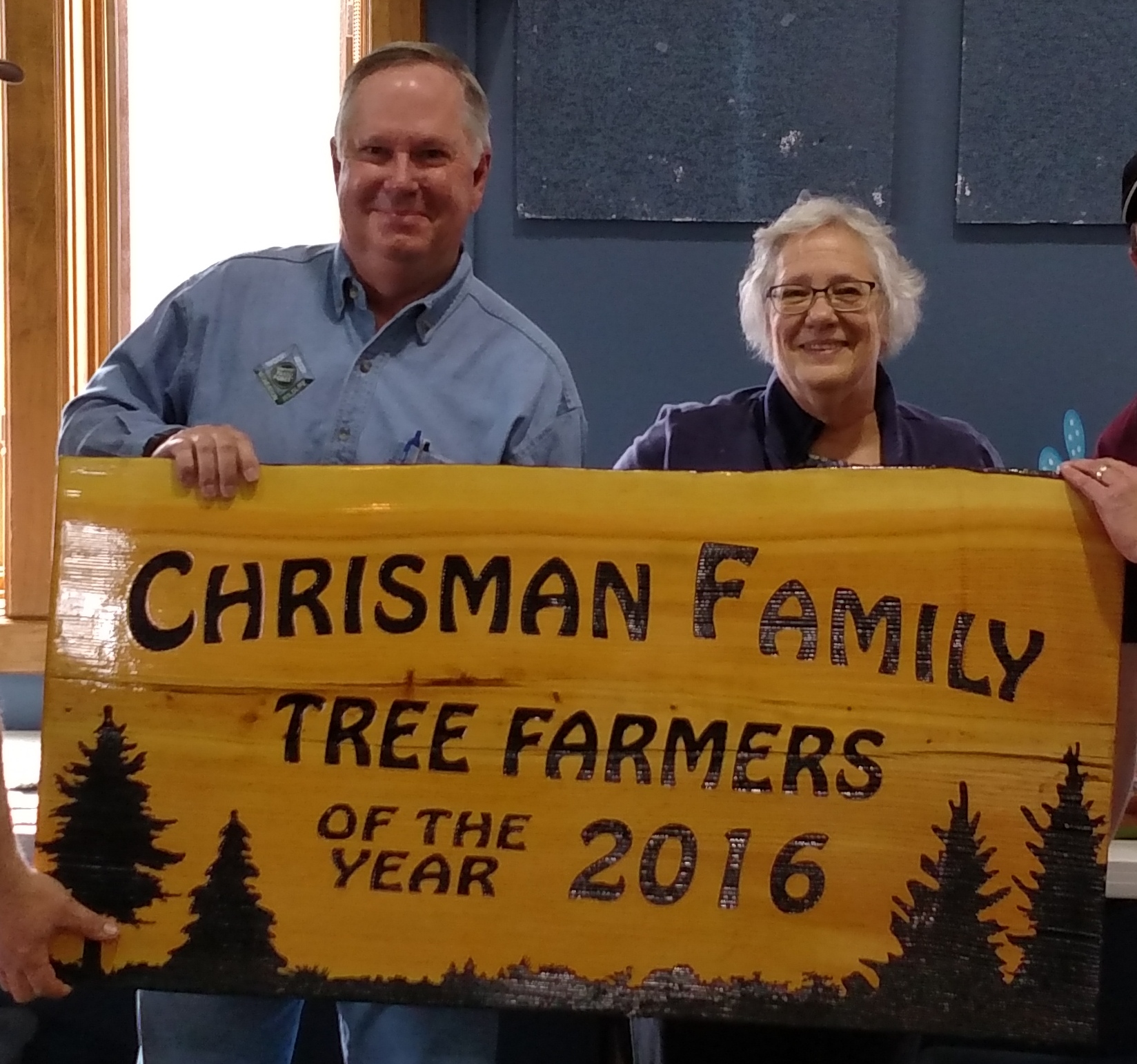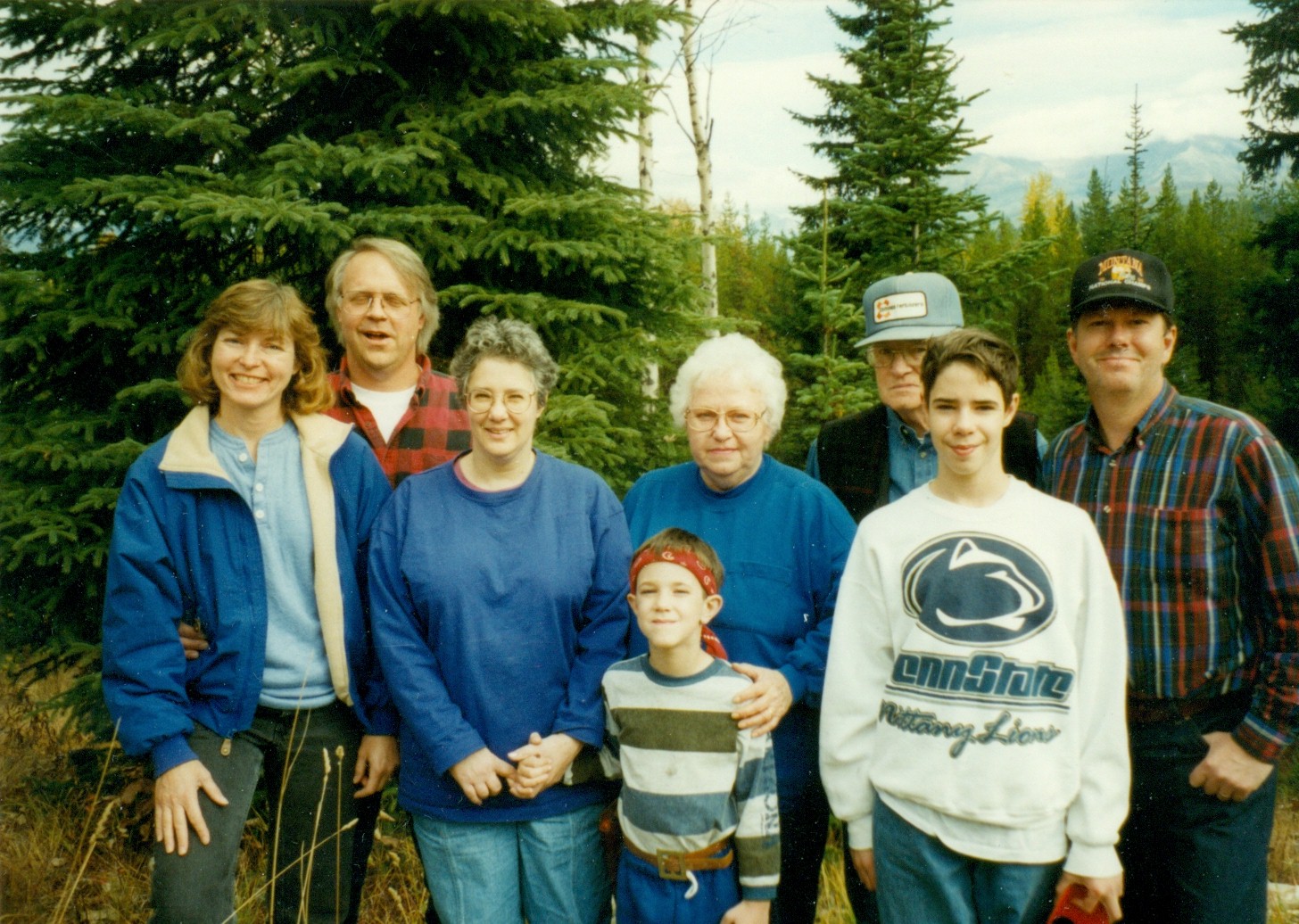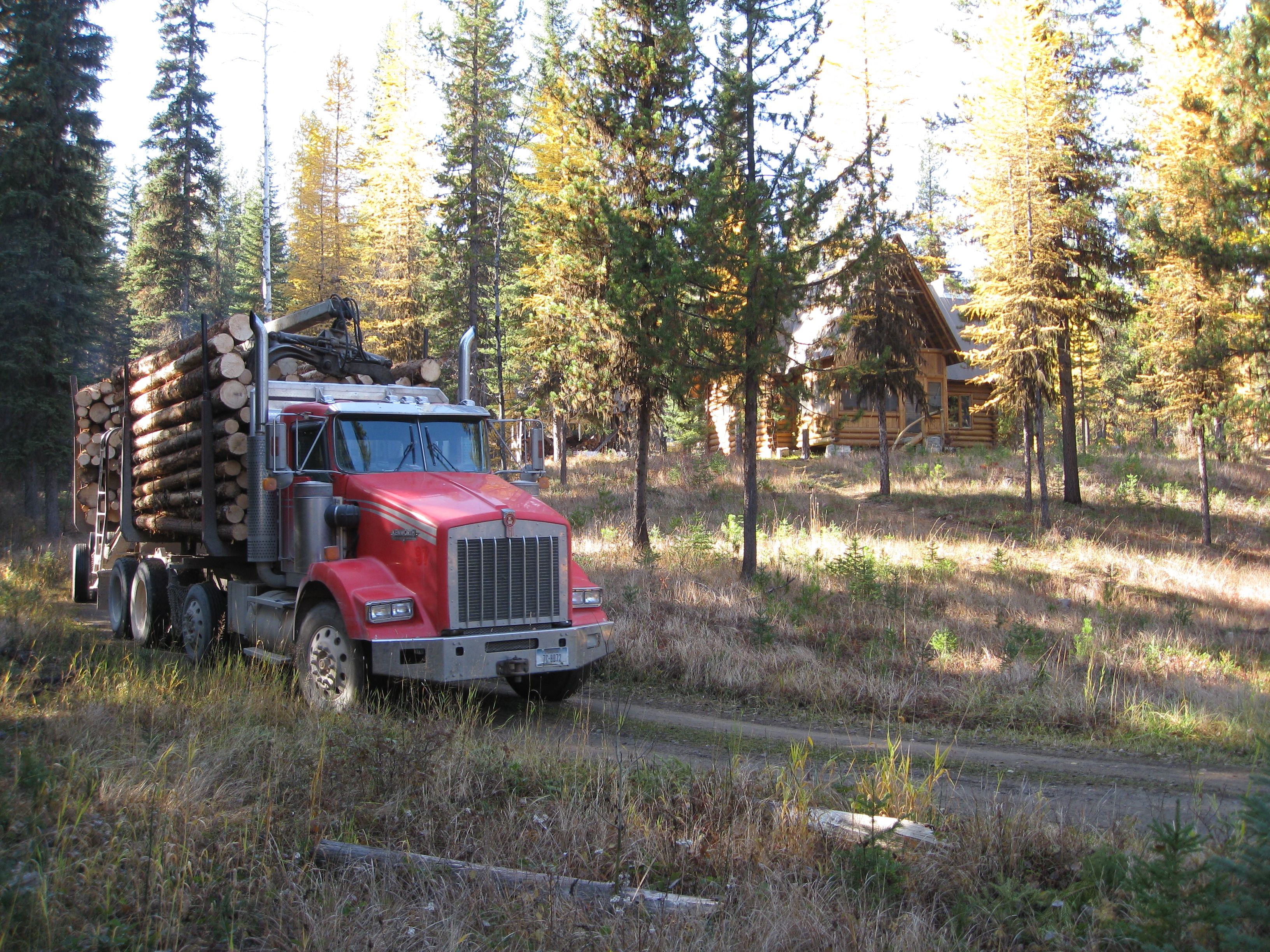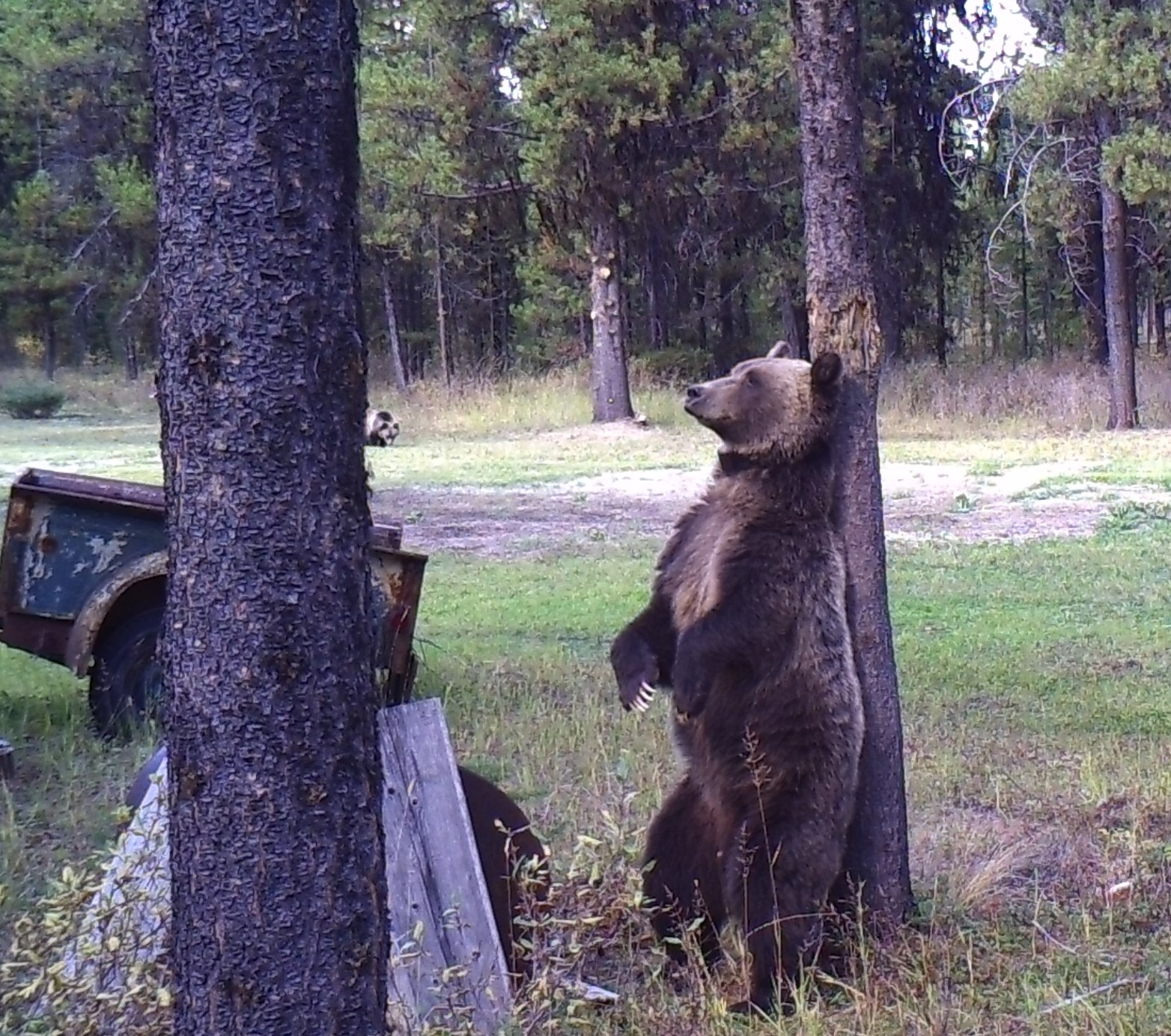Chrisman Family from Montana
 What Makes Them Outstanding?
What Makes Them Outstanding?
The Chrisman Family Forest is a remarkable Tree Farm in the North Fork of the Flathead River Valley in Montana, just west of Glacier National Park and five miles south of the Canadian Border. The 310 acre property was purchased by Baird and Esther Chrisman in 1958 from the estate of Bart Monahan, the original homesteader who filed on the property in the 1920s. Baird and Estherís son Allen and their daughter Kari (Chrisman) Wiley, grew up playing in the streams, forests and meadows of their family forest. It was purchased as a family get-away to the mountains, far away from the corn and soybean fields and flatlands of their native Illinois. The time spent growing up on the North Fork led Allen to pursue a career in Forestry, and both he and Kari chose to attend the University of Montana in order to be closer to the North Fork. Active forest management began with lodgepole pine salvage harvest in the late 1970s during a mountain pine beetle epidemic followed by commercial thinning, hazardous fuels projects, and extensive pre-commercial thinning. With a management plan written by Allen, the Chrisman property was accepted into the American Tree Farm System in 1997.
The Chrisman Family Forest is an excellent example of management for multiple objectives. As Allen says, ďwe grow grizzly bears, and harvest the occasional lodgepole pine sawlog.Ē The property is rich in wildlife and native vegetation, scenic views, recreation opportunities and draws friends and family from all over the country.
Tree Farmer Story
When Baird and Esther purchased the Monahan Homestead in 1958, they were seeking solitude and a place in the mountains to spend family vacations away from the heat and humidity of their native Illinois. The one-room homestead cabin was made habitable in the first year as the family used that for cooking and meals, but slept in a travel trailer they pulled from Illinois. The focus then shifted to building a log cabin large enough to accommodate the growing family, as well as visitors. Baird and Esther would bring nephews out each summer with the offer of room and board and some wage for work on the cabin. When the two story cabin was completed in 1965, the family settled in to enjoy the North Fork.
The mysteries of the Montana woods became a learning experience for Allen and Kari and friends and family who visited. Whitetail deer were constant visitors, along with the chipmunks and ground squirrels. Occasionally a black bear was seen, but very rarely was there any indication of grizzly bears except for the distinctive track in the snow during hunting season. The Kintla Trail ran through the property making a foot highway north to neighbors a mile and a half away, or south to the old Kintla Ranch a mile away. Allen and Kari learned to navigate through the timber, to identify tracks and sign, and picked up other woods skills, all the time viewing it as a big adventure. Horses rented for the summer expanded their exploration of the woods and honed their navigation skills. Nephews, friends and relatives that visited the North Fork looked forward to their next trip. For many it was truly a life-changing experience compared to the urban areas in which they had been raised. They relished the adventure of living in the forest.
When the Chrisman family bought the North Fork property in 1958, the natural setting in the mountains of Montana was just what they were looking for. As with many other new forest landowners, they did not want any changes to come to the forest they loved. They cut dead lodgepole pine for firewood, and cleared seedling/sapling encroachment from the meadow, but aside from that they implemented no management activities.
That changed in 1977 when a major mountain pine beetle epidemic struck the North Fork. Allen, now a Forester with the Bureau of Land Management in Oregon, took a week off to lay out the salvage sale and prepare the contract. With his father, Allen helped to select the logger and negotiate the contract. Over the next four years, over 100 acres of lodgepole pine sawlogs were salvaged, nearly all while they were still green. Since most of the property had a nice mixture of Engelmann spruce, western larch and subalpine fir with a minor component of lodgepole pine, salvage harvest in those areas was either light or non-existent.Because of the widespread harvest around their ownership, portions of the Chrisman property made excellent security cover for wildlife, and could even be picked out on a LandSat photo of Montana in the early 1980s. Natural regeneration in the harvest units was excellent.In the summer of 1997 Allen took four months off from his job with the Forest Service. He prepared a Management Plan which met the requirements of the American Tree Farm System and the Chrisman Family Forest was accepted as Tree Farm.A second cabin was constructed in the early 1990s, and grandsons Allen Baird and Mark spent wonderful times with Grandma and Grandpa at the cabin - riding on the four wheeler, riding on the small dozer, floating the river and exploring the Tree Farm. The time with Grandparents Baird and Esther at the cabin were memories the boys still treasure. They saw moose and deer, elk and bear, and even saw mountain lions out the front window of cabin.The cabin became the place for adventure for the boys. Bringing friends and cousins, they slept in bunk beds and in tents, played ambush in the brush, and even brought a group of friends up for a major paintball war. Each of the boys enjoyed floating the river and learned early the safety rules of river rafting.
now a Forester with the Bureau of Land Management in Oregon, took a week off to lay out the salvage sale and prepare the contract. With his father, Allen helped to select the logger and negotiate the contract. Over the next four years, over 100 acres of lodgepole pine sawlogs were salvaged, nearly all while they were still green. Since most of the property had a nice mixture of Engelmann spruce, western larch and subalpine fir with a minor component of lodgepole pine, salvage harvest in those areas was either light or non-existent.Because of the widespread harvest around their ownership, portions of the Chrisman property made excellent security cover for wildlife, and could even be picked out on a LandSat photo of Montana in the early 1980s. Natural regeneration in the harvest units was excellent.In the summer of 1997 Allen took four months off from his job with the Forest Service. He prepared a Management Plan which met the requirements of the American Tree Farm System and the Chrisman Family Forest was accepted as Tree Farm.A second cabin was constructed in the early 1990s, and grandsons Allen Baird and Mark spent wonderful times with Grandma and Grandpa at the cabin - riding on the four wheeler, riding on the small dozer, floating the river and exploring the Tree Farm. The time with Grandparents Baird and Esther at the cabin were memories the boys still treasure. They saw moose and deer, elk and bear, and even saw mountain lions out the front window of cabin.The cabin became the place for adventure for the boys. Bringing friends and cousins, they slept in bunk beds and in tents, played ambush in the brush, and even brought a group of friends up for a major paintball war. Each of the boys enjoyed floating the river and learned early the safety rules of river rafting.
As sons Baird and Mark got older, Allen enlisted them in helping with trail maintenance, piling slash, stacking firewood and spraying weeds. Even this hard work did not discourage their love of the cabin.By the 1990s, Baird and Esther had gifted the property to Allen and Kari and their spouses Charlotte and Tim. Baird had a good sense of how best to pass on the property - and did it over several years to avoid tax liability.Building the cabins and outbuildings over the years was an early focus for the Chrisman family. While skilled contractors were used for the log work, Baird did most of the carpentry, electrical and plumbing work in the 1960ís cabin, and contributed significantly to the 1990ís cabin.
During construction of the main cabin in the 1990ís, Allen and his father undertook clearing trees to enhance the view of peaks in Glacier Park to the East. Allen did the falling, bucking, and choker setting, and Baird did the skidding using the small dozer. The logs they harvested were bartered with the RBM mill in the Valley for finished flooring used in the cabin.
The Chrisman Family Forest is important to the family in other ways. Beginning in 1978, ashes of several family members have been interred in a family plot on the property, one of the special sites identified in the Management Plan. Bairdís ashes are there, interred after his passing in 2003. The family has plans to inter Estherís ashes next to Bairdís in 2017 as she passed away in 2016.Taking care of the land was a value that Baird and Esther treasured, and they passed on that value to their children and grandchildren. That philosophy is evident in all aspects of management of the Chrisman Family Forest.
Wood
 In 1977, with the mountain pine beetle epidemic targeting the overmature lodgepole pine stands, the family was aggressive in implementing a salvage sale using conventional dozer skidding as well as horse logging in sensitive areas. The fact that Baird and Allen put together a contract so quickly meant that the lodgepole were sold as green or recently dead, and in contrast to other landowners the Chrismanís were in before the market was saturated.
In 1977, with the mountain pine beetle epidemic targeting the overmature lodgepole pine stands, the family was aggressive in implementing a salvage sale using conventional dozer skidding as well as horse logging in sensitive areas. The fact that Baird and Allen put together a contract so quickly meant that the lodgepole were sold as green or recently dead, and in contrast to other landowners the Chrismanís were in before the market was saturated.
Forest management has included planting 1,000 bare root ponderosa pine seedlings in 1980 to encourage diversity in the regenerated stands. Natural regeneration is extensive and is predominantly lodgepole pine. Precommercial thinning was begun in 1991 not only for stocking control but to convert predominantly lodgepole pine stands to a rich mixture of western larch and lodgepole pine. Over 40 acres of precommercial thinning have been completed by Allen since 1991.
A commercial post and pole harvest was implemented in 1991 to remove small diameter lodgepole pine stands infested with mistletoe. Commercial thinning was implemented on 50 acres in 1997 with a cut-to-length harvesting system using a processer and forwarder, eliminating landings and minimizing disturbance.In 2009 and 2013 Allen received hazardous fuels mitigation grants to treat forest fuels around the cabin complex. He laid out the sales, developed the contract and selected the logger. To meet the Landowner share in the grants, Allen contributed thinning and pruning as well as did the slash burning using the dozer to push piles in for complete consumption. The result of these two projects provides some 15 acres of defensible space around the cabin complex.
In 2010 Allen approached the Forest Service to propose a cost share survey for their common boundary. This was successfully completed in 2012, and it included correcting a BLM corner placed in error in the 1980s.
Water
The Chrisman Family Forest is blessed with several clear springs, but all go underground in the porous soils before leaving the property. The main spring near the Homestead Cabin provided domestic water for the family for decades before a well was drilled in the early 1990s. The family filed water rights for domestic use in the 1970ís.The springs provide important riparian areas throughout the property. Rich in wildlife value, the riparian areas host a wide variety of browse species including aspen, willow, and redosier dogwood. As part of the riverine benches in the North Fork River valley, the springs help recharge the river aquifer.
During lay out of the initial timber sale in 1977, Allen flagged streamside management zones as exclusion areas in the contract. He also laid out the road system, maintaining adequate distance from springs and streams, and selected the stream crossing location necessary to access one of the salvage units. The contract specified a native timber bridge with minor abutments and no channel disturbance. The bridge was used in 1978 for salvage, and in 1991 for post and pole harvest. Stringers were replaced in 1997 and the bridge was reconfigured for 4 wheeler use with new decking.During implementation of the hazardous fuels projects in 2009 and 2013 Allen flagged in the Stream Management Zones and monitored logging activities close to them.
In 2015, Allen designed and implemented a sprinkler system using a high pressure pump in the main spring. A trunk line runs to all the structures with garden hose laterals feeding impact sprinklers. The system can irrigate the vegetation surrounding the structures to keep it green and fire resistant. The system is also designed to be able to fill water tanks/tenders directly during fire suppression or connect to a fire hose as needed.
Wildlife Including Threatened and Endangered Species
 The Chrisman Family Forest is a wildlife haven, and it is no accident that the diversity of wildlife species now exceeds that which was present when the property was purchased in 1958. Not only are elk, moose and deer present, but both black bears and grizzly bears are common which was not the case in the 1950ís. Wolves are back which were conspicuously absent in the 1950s. Mountain lions are present, as well as bobcat, coyote and Canada Lynx. The range of small mammals and birds of prey are incredible as well.Wildlife habitat improvement is an important part of the management objectives for the Tree Farm. Prescribed fire is used for willow regeneration to increase browse for elk and moose. Brush cutters are used to remove decadent willow and redosier dogwood stems to stimulate sprouting for browse. Redosier dogwood cuttings have been planted to increase the browse in riparian areas. Aspen stands are enhanced by removing encroaching conifers and encouraging regeneration.
The Chrisman Family Forest is a wildlife haven, and it is no accident that the diversity of wildlife species now exceeds that which was present when the property was purchased in 1958. Not only are elk, moose and deer present, but both black bears and grizzly bears are common which was not the case in the 1950ís. Wolves are back which were conspicuously absent in the 1950s. Mountain lions are present, as well as bobcat, coyote and Canada Lynx. The range of small mammals and birds of prey are incredible as well.Wildlife habitat improvement is an important part of the management objectives for the Tree Farm. Prescribed fire is used for willow regeneration to increase browse for elk and moose. Brush cutters are used to remove decadent willow and redosier dogwood stems to stimulate sprouting for browse. Redosier dogwood cuttings have been planted to increase the browse in riparian areas. Aspen stands are enhanced by removing encroaching conifers and encouraging regeneration.
Noxious weeds are always a concern and the Chrisman Family Forest is an example of excellent weed management. Using appropriate herbicide according to manufacturerís specifications, mechanical treatments including mowing, weed eating and hand pulling, the Chrismanís are aggressive in tackling new invaders and continually monitoring and retreating existing populations.Allen found two bear rub trees in the cabin complex in 2013. A game camera set up on one in 2014 has produced incredible grizzly bear photos, along with black bears, moose, elk, deer, coyotes, and mountain lion.
Allen routinely reports grizzly bear sightings to Grizzly Bear Specialist Tim Manley, and shares game camera photos with him to identify collared bears. The family believes it is important that routine sightings are reported, so that FWP knows that there are encounters with no adverse outcomes.
Recreation and Aesthetics Including Special Sites
The property was purchased in 1958 primarily for recreation. Baird and Esther had no idea of the multiple resource benefits that the property would provide nearly 60 years later as a Certified Family Forest. The scenic view looking east into Glacier National Park is incredible. Mature, large diameter western larch and Engelmann spruce trees frame the views from the windows in the Main Cabin. Hazardous fuels clearing and mowing fine fuels around the cabins creates a park-like environment with superior leave trees forming an open forest canopy.
Roads on the property are mowed to control encroachment, reduce weeds, and create fuel breaks. This makes the roads attractive for family hikes and helps visitors explore the property while being able to find their way home. Trails are maintained using weed-eaters and brush cutters. Two foot bridges crossing streams are constructed from lodgepole pine and have been replaced several times over the decades. That makes a great family project, as sons Baird and Mark were able to help with the construction. Safety in grizzly country is a big concern. Strict control of attractants, improving sight distances along roads and trails and around structures, and insuring that all visitors are instructed in the use of bear spray and carry it has resulted in no encounters despite the increeased bear population.
Berry picking, mushroom picking, wildlife viewing, firewood gathering, hunting deer and elk, target shooting, paintball games, ATV riding, horseback riding, snowshoeing and cross country skiing are all recreational activities enjoyed on the Tree Farm. Close proximity to the North Fork River allows the family to use the property as a launching point for fly fishing and river rafting adventures.
The Tree Farm is a place for all to return to for rejuvenation of the soul and to heal when necessary.


